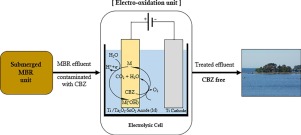当前位置:
X-MOL 学术
›
Appl. Catal. B Environ. Energy
›
论文详情
Our official English website, www.x-mol.net, welcomes your
feedback! (Note: you will need to create a separate account there.)
Removal of carbamazepine from MBR effluent by electrochemical oxidation (EO) using a Ti/Ta2O5-SnO2 electrode
Applied Catalysis B: Environment and Energy ( IF 20.2 ) Pub Date : 2017-09-06 , DOI: 10.1016/j.apcatb.2017.09.017 Khum Gurung , Mohamed Chaker Ncibi , Marina Shestakova , Mika Sillanpää
Applied Catalysis B: Environment and Energy ( IF 20.2 ) Pub Date : 2017-09-06 , DOI: 10.1016/j.apcatb.2017.09.017 Khum Gurung , Mohamed Chaker Ncibi , Marina Shestakova , Mika Sillanpää

|
This study aims at investigating the electrochemical oxidation (EO) of carbamazepine (CBZ) synthetic solutions and real membrane bioreactor (MBR) effluent using newly developed Ti/Ta2O5-SnO2 electrodes to enhance CBZ removal. The characterization of the prepared Ti/Ta2O5-SnO2 electrodes was performed by using scanning electron microscope, energy dispersive X-ray spectroscope, atomic force microscope, and cyclic voltammetry analyses. The main operating parameters influencing the CBZ removal efficiency in synthetic solutions using Ti/Ta2O5-SnO2 electrodes were evaluated including the applied current density, initial CBZ concentration, pH, and temperature. The optimum removal of CBZ (20 mg L−1) and TOC reached 75.5%, and 71.1%, respectively, after 8 h of electrolysis, under current density of 9 mA cm−2, pH 6, temperature of 30 °C, and using 0.1 M Na2SO4 as supporting electrolyte. Increasing current density and temperature influenced the CBZ removal, unlike pH which did not have significant influence on CBZ removal. The performance of Ti/Ta2O5-SnO2 electrode was compared with conventional Ti/PbO2 electrode in terms of CBZ removal efficiencies and stability of the electrodes. The results showed that under the same operating conditions, the CBZ removal efficiency of Ti/PbO2 electrode was slightly higher than of Ti/Ta2O5-SnO2 (77.9 and 71.7%, respectively). Nonetheless, the use of this newly developed electrode is more energy-efficient as it required the lowest energy consumption of 60.3 kWh m−3 to achieve optimum CBZ removal, in addition to fact that no heavy metals were leached (unlike the PbO2 electrode). Furthermore, a complete degradative removal of real MBR effluents spiked with CBZ was achieved when electrolyzed under the optimized conditions of CBZ synthetic solutions. Overall, the EO based on the use of Ti/Ta2O5-SnO2 electrode was found to be a reliable approach to remove CBZ from contaminated waters, with promising potential for integration with MBR technology to remediate CBZ.
中文翻译:

使用Ti / Ta 2 O 5 -SnO 2电极通过电化学氧化(EO)从MBR废水中去除卡马西平
这项研究旨在研究使用新开发的Ti / Ta 2 O 5 -SnO 2电极来增强卡马西平(CBZ)合成溶液和真实膜生物反应器(MBR)废水的电化学氧化(EO),以增强CBZ的去除能力。通过使用扫描电子显微镜,能量色散X射线光谱仪,原子力显微镜和循环伏安法分析对制备的Ti / Ta 2 O 5 -SnO 2电极进行表征。影响使用Ti / Ta 2 O 5 -SnO 2的合成溶液中CBZ去除效率的主要操作参数评估电极,包括施加的电流密度,初始CBZ浓度,pH和温度。在电流密度为9 mA cm -2,pH 6,温度为30°C和温度为8 mA的情况下,电解8小时后,CBZ(20 mg L -1)和TOC的最佳去除率分别达到75.5%和71.1%。使用0.1 M Na 2 SO 4作为支持电解质。电流密度和温度的升高会影响CBZ的去除,而pH值对CBZ的去除没有显着影响。将Ti / Ta 2 O 5 -SnO 2电极的性能与常规的Ti / PbO 2进行了比较电极的CBZ去除效率和电极稳定性。结果表明,在相同的操作条件下,Ti / PbO 2电极的CBZ去除效率略高于Ti / Ta 2 O 5 -SnO 2(分别为77.9和71.7%)。尽管如此,使用这种新开发的电极更加节能,因为它需要最低的能耗60.3 kWh m -3才能实现最佳的CBZ去除,此外还没有浸出重金属(与PbO 2不同)电极)。此外,在优化的CBZ合成溶液条件下进行电解时,可以完全降解去除掺有CBZ的实际MBR废水。总体而言,发现基于Ti / Ta 2 O 5 -SnO 2电极的EO是一种从受污染的水中去除CBZ的可靠方法,有望与MBR技术整合以修复CBZ。
更新日期:2017-09-07
中文翻译:

使用Ti / Ta 2 O 5 -SnO 2电极通过电化学氧化(EO)从MBR废水中去除卡马西平
这项研究旨在研究使用新开发的Ti / Ta 2 O 5 -SnO 2电极来增强卡马西平(CBZ)合成溶液和真实膜生物反应器(MBR)废水的电化学氧化(EO),以增强CBZ的去除能力。通过使用扫描电子显微镜,能量色散X射线光谱仪,原子力显微镜和循环伏安法分析对制备的Ti / Ta 2 O 5 -SnO 2电极进行表征。影响使用Ti / Ta 2 O 5 -SnO 2的合成溶液中CBZ去除效率的主要操作参数评估电极,包括施加的电流密度,初始CBZ浓度,pH和温度。在电流密度为9 mA cm -2,pH 6,温度为30°C和温度为8 mA的情况下,电解8小时后,CBZ(20 mg L -1)和TOC的最佳去除率分别达到75.5%和71.1%。使用0.1 M Na 2 SO 4作为支持电解质。电流密度和温度的升高会影响CBZ的去除,而pH值对CBZ的去除没有显着影响。将Ti / Ta 2 O 5 -SnO 2电极的性能与常规的Ti / PbO 2进行了比较电极的CBZ去除效率和电极稳定性。结果表明,在相同的操作条件下,Ti / PbO 2电极的CBZ去除效率略高于Ti / Ta 2 O 5 -SnO 2(分别为77.9和71.7%)。尽管如此,使用这种新开发的电极更加节能,因为它需要最低的能耗60.3 kWh m -3才能实现最佳的CBZ去除,此外还没有浸出重金属(与PbO 2不同)电极)。此外,在优化的CBZ合成溶液条件下进行电解时,可以完全降解去除掺有CBZ的实际MBR废水。总体而言,发现基于Ti / Ta 2 O 5 -SnO 2电极的EO是一种从受污染的水中去除CBZ的可靠方法,有望与MBR技术整合以修复CBZ。











































 京公网安备 11010802027423号
京公网安备 11010802027423号